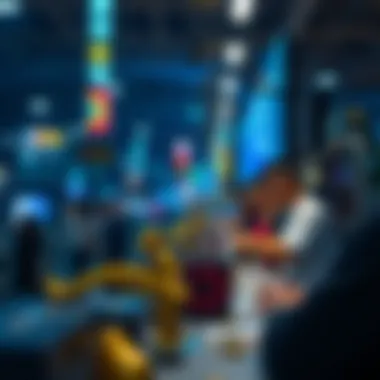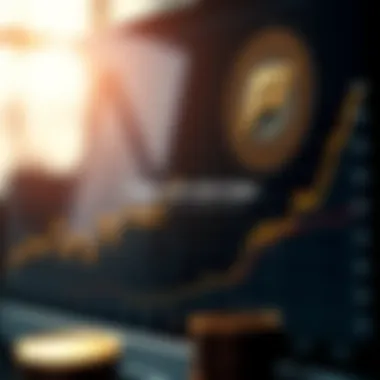Dynamics of the Crypto Art Market Explained


Intro
The intersection of art and technology is not a new concept, yet the surge of crypto art has brought this blending to uncharted territories. The crypto art market represents a pivotal shift in how we think about ownership, value, and the very nature of art itself. With the proliferation of non-fungible tokens (NFTs), artists are now empowered to reach global audiences, bypassing traditional gatekeepers.
In this exploration of the crypto art market, we’ll dissect how blockchain technology underpins this innovative domain, the trends currently shaping it, and the implications for all stakeholders involved—artists, collectors, and investors alike.
Cryptocurrency Fundamentals
Understanding Blockchain Technology
At the core of crypto art lies blockchain technology. It’s akin to a digital ledger that records transactions across many computers, creating an immutable record of ownership. This ensures that once a piece of art is tokenized as an NFT, its ownership can be traced back to its original creator, offering a layer of transparency unheard of in the traditional art world.
- Decentralization: Unlike traditional systems where a single entity holds control, blockchain operates on a distributed network.
- Immutability: Once data is recorded on the blockchain, it cannot be altered, guaranteeing the authenticity and provenance of each NFT.
- Smart Contracts: These self-executing contracts with terms of the agreement directly written into code enable creators to receive royalties on secondary sales, creating an ongoing revenue stream.
Key Concepts in Cryptocurrency Trading
To understand crypto art fully, grasping the fundamentals of cryptocurrency trading is essential.
Market Volatility: Cryptocurrencies can swing in value remarkably, which might affect the market for art sold in these tokens.
Liquidity: Some assets in the crypto space can be more liquid than others, influencing how fast art can be bought or sold.
Diversification: Just like stocks, spreading investments across different artists or styles can minimize risks in the unpredictable crypto landscape.
Understanding these concepts provides a foundation for engaging with the broader crypto art ecosystem. As we move forward, recognizing the dynamics at play enhances both appreciation and strategic investment in this novel field.
Market Insights
Current Trends in the Crypto Market
The landscape of the crypto art market is continuously evolving. Major trends currently include:
- Increased Artist Adoption: More creators are exploring digital mediums to tokenize their work.
- Rise of Community-Driven Platforms: Platforms like Foundation and Rarible allow artists to connect directly with art enthusiasts, enabling a more grassroots approach.
- Environmental Concerns: Ongoing discussions around the carbon footprint of blockchain networks are driving innovations towards more sustainable solutions.
Analyzing Market Movements and Predictions
Market behavior reflects broader societal trends, and the crypto art market is no exception. As we analyze movements, several predictions come to light:
- Increased Regulatory Scrutiny: Following the footsteps of broader cryptocurrency regulations, users may soon face stricter guidelines.
- Integration of AI in Art Creation: The future may see even further amalgamation of AI tools in the creation of art, leading to new forms of digital expression.
- Enhanced Interactivity: New platforms may allow for interactive art pieces, altering how buyers engage with art in a digital sphere.
Investors and traders should keep a close eye on these developments. By doing so, they may spot opportunities before they become mainstream, potentially leading to lucrative ventures in this exciting new frontier.
Through understanding these core elements of the crypto art market, stakeholders can make informed decisions about their roles within this fast-paced environment. As we proceed further into this narrative, familiarizing oneself with these dynamics becomes crucial in navigating the landscape ahead.
Preface to Crypto Art
The rise of crypto art represents a significant shift in the landscape of the art world. This section aims to lay the groundwork for understanding how digital innovation is challenging the established norms of art creation, distribution, and ownership. These developments offer a variety of implications for artists, collectors, and investors alike, making it crucial to grasp the fundamental dynamics at play.
As digital assets gain traction, understanding crypto art becomes essential. This form of art primarily exists in the digital realm, often tied to blockchain technology, which provides the framework for verifying ownership and authenticity. Here, we witness a merging of artistic expression with technological innovation, creating new pathways for revenue generation and audience engagement. The benefits of these advancements are not merely technical; they open doors for emerging artists to showcase their work globally without the constraints of physical galleries or traditional art market gatekeepers.
Moreover, exploring the nuances of crypto art leads us to appreciate its role in democratizing the art market. Artists who previously faced barriers now have direct access to collectors through various platforms, allowing for a more equitable distribution of opportunities. With an increasing number of transactions occurring through non-fungible tokens—or NFTs—the term "crypto art" has evolved to embody thrilling potential for both artistry and investment.
Defining Crypto Art
At its core, crypto art refers to digital creations tied to blockchain technology, most commonly through NFTs. These tokens are unique digital certificates that verify and signify ownership of a digital asset, which may include images, videos, or even music. The technology behind it ensures that each piece is distinct and cannot be replicated or tampered with, fundamentally changing how we perceive originality in the digital space.
This new genre of art is not without its complexities. Artists use various tools to create their works, from graphic design software to 3D modeling programs. The freedom of expression allowed in the digital realm presents a canvas limited only by the creator's imagination. As such, crypto art is characterized by its diversity—there's no singular style, but rather a wide array of aesthetics and concepts.
The implications of defining crypto art are significant. It challenges long-held beliefs about value, originality, and the role of technology in creativity.
"Crypto art redefines what it means to own a piece of art, blending creativity and technology in unprecedented ways."
The Birth of NFTs
The inception of non-fungible tokens heralded a new era for the art world. Although blockchain technology has existed for years, the realization of NFTs can be traced back to projects like CryptoPunks and CryptoKitties, which came onto the scene in 2017. These early projects sparked interest in digital ownership, allowing users to buy, sell, and breed unique digital characters—leading to the development of a market where digital collectibles flourished.
As artists began to recognize the potential of NFTs, platforms like OpenSea, Rarible, and Foundation emerged, providing spaces specifically tailored for crypto art. The allure of creating and selling art in this context came with the promise of not only royalties through smart contracts but also the chance to reach a global audience instantly.
Consequently, the birth of NFTs has not only introduced new ways for artists to monetize their work but has also laid the groundwork for speculative investment opportunities that draw in collectors and investors from various backgrounds. As these tokens gained popularity, discussions around their implications for copyright, ownership, and the future of art became increasingly pertinent, driving curiosity and debate within the art community and beyond.
The Intersection of Technology and Art
The crossroads where technology meets art represents a fascinating and transformative space in today's digital economy. It reshapes not only how art is created but also how it is perceived, valued, and traded. This intersection is particularly crucial in the realm of crypto art, allowing new artists to emerge and thrive, while presenting unprecedented opportunities and hurdles for established creators. In this section, we will delve into two particular facets of this dynamic: blockchain technology and smart contracts, both of which are redefining the landscape of artistic expression.


Blockchain Technology Explained
Blockchain technology serves as the backbone of the crypto art market. At its core, a blockchain is a transparent ledger that records transactions across a network of computers. This decentralized nature ensures that once information is recorded, it cannot be altered or deleted without consensus among participants in the network.
The implications for artists are significant. For instance, when an artwork is minted as a non-fungible token (NFT) on a blockchain, it gains a verifiable authenticity that traditional methods simply can't provide. Each piece is traceable back to its creator, making the forgeries much harder to carry out. Moreover, the transparent record of transactions boosts trust not just among consumers but also within the broader community of creators.
The use of blockchain facilitates:
- Provenance Tracking: Artists and collectors can trace the history of ownership, adding value and authenticity to the artwork.
- Decentralized Ownership: Unlike traditional art markets, where intermediaries often play a significant role, blockchain allows direct sales between artists and collectors.
- Access to Global Markets: Creators can promote and sell their work to a worldwide audience, breaking the geographical barriers that often restrict local artists.
In a nutshell, blockchain technology is not merely an IT trend; it is actively redefining the nature of trust and ownership in the art world.
Smart Contracts and Royalties
At first glance, smart contracts might sound a bit sci-fi, but their practical applications in the art market are integral for both artists and collectors. A smart contract is essentially a self-executing contract with the terms of the agreement directly written into code. This technology automates transactions, removing the need for middlemen and thereby reducing costs.
The benefits extend to royalty distribution for artists—an often overlooked aspect in traditional art markets. With smart contracts, artists can automatically receive a percentage of sales whenever their work is resold in the secondary market. This feature has the potential to create a sustainable income stream for artists who might otherwise only enjoy a one-time payment.
Consider these key points:
- Automatic Enforcement: The contract executes without the need for a third party, ensuring transparency and efficiency.
- Fair Compensation: Artists are protected against the typical scenarios of undervaluation and lack of recognition that can occur in traditional art sales.
- Ongoing Engagement: Artists can maintain a relationship with their work and benefactors long after the initial sale, fostering community ties.
"Smart contracts ensure that artists are compensated fairly, fostering an ecosystem where creativity can flourish without being stifled by the traditional financial limitations."
As we look ahead, smart contracts provide a compelling prospect for the future of creative industries, highlighting just how intertwined technology and art have become.
Current Trends in the Crypto Art Market
The landscape of the crypto art market is evolving rapidly, making it a pertinent topic to explore deeply. This section sheds light on how these changes shape not only the artistic community but also the broader investment realm. Trends in crypto art are crucial for understanding the intricate dynamics at play and the implications for both artists and collectors. Keeping tabs on these trends can open the door to unique opportunities and insights, whether you're an investor, an artist, or just someone with a keen interest in the intersection of art and technology.
Mainstream Awareness and Celebrity Involvement
In recent years, there’s been a noticeable uptick in mainstream awareness surrounding crypto art. The involvement of celebrities has further fueled this interest. Stars from various fields, such as music, acting, and sports, have embraced non-fungible tokens (NFTs) as a novel way to connect with their followers and monetize their creative output.
For instance, musicians like Grimes and artists such as Beeple have seen staggering success. Beeple’s piece, "Everydays: The First 5000 Days," sold for an eye-popping $69 million at Christie's, signaling the time when a digital artwork could fetch prices that rival traditional masterpieces.
The presence of well-known personalities not only legitimizes the market but also amplifies its reach, capturing the attention of those who may not have previously engaged with digital art. Many people now see NFTs as not just a passing trend but a powerful medium that has carved its own niche within the art industry.
“Celebrity involvement injects confidence into the market, showcasing the potential of digital art to a much broader audience.”
Factors driving this trend include:
- Social Media Promotion: Platforms like Twitter and Instagram enable artists to reach out to wider audiences.
- Collaborations: Partnerships between artists and brands or celebrities foster innovative projects, further pushing into the mainstream.
- Exclusive Content: Limited editions tied to influencer appeal heighten the allure of purchasing NFTs.
Yet, while celebrity involvement has its benefits, it also raises questions. The market can easily become flooded with low-quality work or hype-driven sales, which leaves investors navigating through a minefield, trying to distinguish genuine talent from mere noise.
Emerging Artists and Diverse Voices
Alongside the wave of celebrity-backed projects, a new wave of emerging artists is capturing the moment in the crypto art scene. Artists from diverse backgrounds are finding their voices in an increasingly democratized space. Unlike traditional art markets, where access can be limited by gatekeepers and high entry costs, the crypto art world enables individuals to showcase their talent without the need for large establishments.
Platforms such as OpenSea, Rarible, and Foundation have become havens for those willing to explore art in innovative formats and styles, often reflecting a mix of cultural elements, personal experiences, and social commentary. This has led to a few notable shifts:
- Inclusivity: There is a broader representation of voices, with artists from various cultural backgrounds sharing narratives that resonate with more people.
- Experimental Art Forms: Some creators are pushing the boundaries of digital art, experimenting with augmented reality and interactive pieces that traditional art forms cannot replicate.
- Community Focus: Many artists are building communities around their work, fostering environments that encourage collaboration and support.
The significance of this trend can't be understated. As artists diverge from conventional expectations and embrace their unique perspectives, it enriches the art world as a whole. It creates opportunities for discourse, invites innovation, and challenges the status quo. By promoting a more substantial variety of artistic expressions, the crypto art market is paving the way for dynamic captures of culture and creativity that might have otherwise stayed in the shadows of the mainstream.
Ultimately, the current trends in the crypto art market reveal a vibrant and rapidly changing landscape, highlighting the need for awareness and understanding as technological advancements continue to shape the future of art.
To keep up with these shifts, resources like Wikipedia, Britannica, and forums such as Reddit can provide valuable insights.
Key Platforms for Crypto Art
When it comes to the crypto art arena, the platforms where artists trade, display, and promote their work play a pivotal role. These platforms not only facilitate transactions but also provide a social backbone to the crypto community. The significance of these platforms is multilayered and encompasses several elements, including accessibility for artists, features that enhance user experience, and the vibrancy of the community involved.
Top Marketplaces for NFTs
The marketplace landscape for NFTs is diverse and continues to evolve at a rapid pace. Here are some of the leading platforms making waves in the crypto art world:
- OpenSea
This platform reigns supreme as one of the largest NFT marketplaces. OpenSea offers a user-friendly interface, making it accessible for newcomers and veterans alike. Collectors can browse numerous digital art pieces and even create their own NFTs with relative ease. - Rarible
Rarible differentiates itself with its community-driven approach. It allows users to actively participate in governance decisions through its native token, RARI. This aspect empowers artists and collectors, giving them a stake in the platform’s future. - Foundation
This platform caters to more curated art. Aimed mainly at artists, it requires an invitation to join for sellers, fostering a sense of exclusivity. The quality of the artwork here is generally high, attracting serious collectors eager to score unique pieces. - SuperRare
SuperRare focuses on high-quality, single-edition art pieces. Artists create extraordinarily unique works, and collectors can be confident that they are obtaining one-of-a-kind tokens. The platform has made a name for itself by prioritizing artists' rights and compensating them fairly.
The evolution of these marketplaces contributes significantly to how artists and collectors interact with digital art. These platforms often host events or auctions, creating thrilling opportunities to gain recognition or snag a sought-after piece.
Social Media's Role in Art Promotion


In the realm of crypto art, social media serves as the beating heart of promotion and interaction. Artists harness platforms like Twitter, Instagram, and Discord not just to showcase their creations, but to engage with their audience and foster community. This dynamic promotes an inclusive atmosphere, which is crucial for a nascent industry like crypto art.
- Twitter
Known for its fast-paced nature, Twitter is a key platform for real-time interaction. Artists can share updates on their latest works or drops, and hashtags like #NFT and #CryptoArt help their visibility. It is not uncommon to see artists tweeting links to their NFT listings alongside previews of the pieces. - Instagram
With its visual-centric approach, Instagram is instrumental in showcasing artworks. The platform's emphasis on imagery allows artists to convey their work's essence and drive engagement through likes and comments. Many artists maintain dedicated accounts solely for their crypto art portfolio, pushing out content regularly to keep their followers interested. - Discord
This platform serves as a hub for artists and collectors to communicate directly. Discord servers centered around crypto art provide spaces for discussion about trends, upcoming drops, and even tutorials for newcomers. The community-centric nature of Discord allows members to support one another, creating a collaborative environment.
As social media continues to shape how individuals engage with crypto art, the platforms that artists choose to use can influence their visibility and success in the marketplace. This interdependence between social media and art platforms demonstrates the integral role of community in this evolving sector.
The platforms for crypto art are not merely marketplaces; they are social ecosystems that shape perception, interaction, and the future of digital creativity.
The Role of Collectors and Investors
In the fast-evolving landscape of crypto art, collectors and investors don’t just influence market dynamics; they embody them. Their actions and decisions offer insights into trends, valuation, and the future potential of digital artworks. This section dives into the heart of why these players are pivotal in shaping the crypto art ecosystem.
Understanding Collector Motivations
Collectors in the realm of crypto art have an array of motivations. Some seek to build a personal digital gallery, while others view their purchases as a way to be part of an innovative movement. It’s not merely about the artwork; it’s about the story behind each piece and the technology that underpins it.
- Passion for Art: At their core, many collectors are driven by a genuine love for art itself. With the rise of NFTs, they can now support artists globally, irrespective of geographic boundaries.
- Investment Potential: Others see this as a new frontier in investment. As the market matures, there’s a perception of value appreciation, akin to traditional art investments. The idea of acquiring a unique digital piece that could skyrocket in value is indeed an appealing draw.
- Social Status and Community Engagement: Owning rare pieces can also confer a level of prestige within highly connected communities. Collectors often share their acquisitions on social media, connecting with like-minded individuals and promoting the artists behind their collections.
Understanding these varied motivations enables artists and platforms to tailor their offerings. For instance, platforms like OpenSea and Rarible spotlight artist stories and creation processes to resonate with collector sensibilities.
Investment Strategies in Crypto Art
Investing in crypto art is not as straightforward as it might seem. These waters can be choppy, requiring a blend of acumen, foresight, and sometimes a bit of luck. Here are several strategies that investors might consider:
- Research and Analytics: Before diving in, understanding an artist’s background, previous sales, and market volubility is key. Platforms like nonfungible.com offer tools to analyze trends and valuation metrics.
- Diversification: As in traditional investments, diversification is crucial. Owning different Artist styles or mediums can balance risk. Collectors could consider investing in multiple artists or genres to hedge against market fluctuations.
- Engagement with Artists: Building relationships with artists can offer insights into upcoming trends. By engaging on social media and attending virtual exhibits, investors can glean information that could steer their purchasing decisions.
"Smart investing in crypto art is about blending aesthetic appreciation with analytical strategy."
- Long-term vs. Flipping: Investors often grapple with whether to hold onto pieces long-term or flip them quickly for profit. Each strategy has its perks and pitfalls. Long-term collecting can lead to monumental gains if the artist hits the mainstream, while flipping requires a keen eye for trends and timing.
As the crypto art market continues to evolve, it's essential for both investors and collectors to remain adaptable. The blend of financial investment and art appreciation creates a unique ecosystem, rich with opportunity yet fraught with challenges. The road ahead is uncertain, but for those that navigate it carefully, the rewards can be significant.
For further reading on market dynamics, collectors can check sources like Investopedia and CoinDesk. Those interested in deeper dives into artist valuation might find ArtNet resourceful.
Challenges Faced in the Crypto Art Market
The rise of crypto art has been nothing short of revolutionary, but every silver lining has its cloud. The challenges faced in the crypto art market are not just speed bumps; they can be major hurdles that affect artists, collectors, and investors alike. Understanding these challenges is crucial, as they reveal the complexities of navigating this still-nascent area. The importance of dissecting these aspects lies in their potential consequences, shaping the strategies of art buyers, sellers, and fans.
Market Volatility and Speculation
When talking about the crypto art market, volatility is a word that comes up more often than not. Prices can swing like a pendulum, sometimes within mere hours. For example, a piece sold for a staggering $69 million could appreciate or depreciate drastically shortly after.
Investors, both savvy and novices, often flood markets during bullish phases, drawn by the allure of quick profits. This frenzy can overshadow the value of art itself, leading to speculations that don't necessarily reflect an artwork’s merit. Once the tide turns, many are left holding the bag, questioning the worth of their investments.
It's not unusual for potential buyers to err on the side of caution. They may find themselves second-guessing the prices they see, worried they might be caught in a pricing bubble. During downward trends, markets can feel in a state of panic, where what was considered an asset turns into a liability overnight. Maintaining a keen eye on these fluctuations is key for anyone involved in the crypto art space.
The emotional rollercoaster that accompanies market volatility often leads to impulsive decisions which may not align with long-term collecting strategies.
Intellectual Property Concerns
Intellectual property (IP) issues loom large in the world of crypto art. With digital creations being traded like commodities, concerns about the originality and ownership of works come into play. The question of who truly owns an art piece is often murky. Just because a piece is sold as an NFT doesn’t mean that copyright has been transferred.
Artists are frequently left in a lurch when collectors misinterpret the sale, thinking they have seller rights that they don't actually possess. For example, selling an NFT does not automatically grant the purchaser the ability to reproduce that artwork. Misunderstandings can lead to legal tussles, which consume valuable time and resources.
Moreover, the ease of copying and recreating digital assets further complicates matters. The potential for plagiarism is high in the digital realm, making it essential for artists to be proactive in protecting their work. They must navigate this minefield while ensuring that their rights are respected.
The balance between innovation and protection is delicate, and many artists feel that their rights are often secondary to the speculative interests of collectors and investors.
In summary, the crypto art market is fraught with challenges, but being aware of these elements can go a long way in informing better decisions and fostering a more sustainable ecosystem. With strides in technology, it may eventually provide tools to mitigate these challenges, but for now, both artists and investors must tread carefully.
Regulatory Landscape and Compliance
As the world of crypto art continues to grow and evolve, understanding the regulatory landscape is crucial for artists, collectors, and investors alike. Compliance with existing laws and the anticipation of future regulations can significantly shape the market dynamics. Regulatory frameworks provide a structure within which crypto art operates, ensuring that participants in this space engage in fair practices and maintain legitimacy.
Governments worldwide are grappling with how to categorize and regulate cryptocurrencies and blockchain technologies, including non-fungible tokens (NFTs) that are pivotal in the crypto art market. Ignoring these regulations can lead to legal repercussions, but adhering to them offers a safer and more professional environment for all parties involved. From taxation to intellectual property rights, each aspect of regulation directly impacts how the market functions.
Government Responses to Crypto Art
Government responses to the emergence of crypto art have varied widely, reflecting differing levels of acceptance and understanding of this novel market. Some nations have embraced the innovation, seeing it as an opportunity to enhance their artistic and economic landscapes. For instance, countries like Canada and the United Kingdom are working on creating frameworks that can cater to crypto artists while ensuring protection against fraud.
On the flip side, there are jurisdictions like China, where strict regulations on cryptocurrencies have led to outright bans on NFT trading. This shows how regulators are still trying to figure out the balance between fostering innovation and preventing financial crime. It’s worth noting that the unpredictability of these regulations can leave artists and investors in a precarious position, where changes can happen at the drop of a hat.
"The response from governments seems to hinge on the potential economic benefits versus the risks involved in crypto art and NFTs, making it a moving target for regulatory compliance."


Some specific actions taken by governments include:
- Tax Regulations: Many countries require that profits from NFT sales be treated as taxable income, which adds another layer of complexity for collectors and artists.
- Money Laundering Regulations: Governments are keen on ensuring that crypto art doesn't facilitate illegal activities, leading to discussions about know-your-customer (KYC) and anti-money laundering (AML) protocols for platforms.
- Consumer Protection Initiatives: Some regulators aim to ensure that buyers are not misled about the value or authenticity of art, which may lead to mandates for transparency regarding sale histories and artist credentials.
Future Regulatory Considerations
Looking ahead, the regulatory environment surrounding crypto art is likely to become even more intricate. As blockchain technology evolves, so will the laws governing it. Here are a few considerations that market participants should keep an eye on:
- Collaborative Frameworks: There’s a potential for global cooperation in establishing standards for digital art. Multi-national approaches could bring consistency to the market and increase investor confidence.
- Evolving Definitions: As more creators and sellers emerge, the need for specific definitions regarding what constitutes crypto art, and its associated rights are becoming more pressing.
- Taxation Policies: Future legislation might dictate clear guidelines on how NFTs are treated tax-wise, providing clarity and possibly encouraging more people to engage in the market without fear of tax implications.
The landscape is in flux, and it's essential for all market players—from artists to investors—to stay abreast of changes and adapt their strategies accordingly. Reviewing legal frameworks regularly and engaging with local communities can provide insights that are not just beneficial but necessary for survival in the crypto art arena.
Future Outlook of the Crypto Art Market
The future outlook of the crypto art market is not merely speculative; it's a kaleidoscope of opportunities that artists, collectors, and investors align themselves with as they navigate this nascent yet dynamic landscape. Understanding what lies ahead is crucial for anyone engaged in this space, as it shapes not just investment strategies, but also the creation and appreciation of art itself in its digital form. The convergence of creativity and technology is not just a momentary trend; it promises a reshaping of the art ecosystem.
Technological Innovations on the Horizon
Technological advancements continuously alter the fundamentals of the crypto art realm. One key innovation that stands to disrupt the existing paradigms is the potential implementation of advanced artificial intelligence algorithms that aid artists in creation. Imagine an artist utilizing AI to actively engage in the creative process, defining parameters while the machine explores artistic styles and techniques unfathomable to human minds alone.
Moreover, augmented reality (AR) and virtual reality (VR) technologies are stepping into the limelight, allowing viewers to interact with art pieces in immersive ways. This tech can transform any environment, creating unique viewing experiences where the audience feels as if they are walking through different artistic worlds. These innovations not only enhance the way art is experienced but also open up new avenues for revenue streams for artists who may choose to present virtual exhibitions.
"The evolution of technology in art expands boundaries and creates experiences beyond visual stimulation."
Blockchain continues to play a vital role as well. More efficient consensus mechanisms and reduced energy consumption will likely gain traction, making transactions smoother and more sustainable. Enhanced security protocols can ease the concerns surrounding data theft and forgeries, ensuring authenticity and trust for both creators and collectors.
Potential Market Growth and Expansion
The potential growth of the crypto art market is significant, driven by several factors. Firstly, mainstream adoption is accelerating, propelled by an influx of institutional investors who recognize the value of NFTs and crypto assets. These entities not only bring financial backing but also credibility. As more traditional galleries and auction houses embrace digital art, the legitimacy of crypto art continues to solidify.
The rise in accessibility for artists across geographic boundaries is another growth catalyst. Platforms like OpenSea and Rarible empower artists from all walks of life to share their work on a global stage, free from the restrictions imposed by traditional art markets. This democratization leads to a diverse array of artistic voices that enrich the market.
Furthermore, the increased intersection of cultural narratives within digital art is creating room for novel expressions. From urban street artists to indigenous creators, various narratives are infusing the crypto art space with fresh perspectives that resonate with wider audiences, unlocking new demographics and potential buyers.
The confluence of these developments suggests not only growth but a structural transformation within the art market itself, reinforcing the role of digital art as a valid and cherished component of the artistic canon.
In summary, the road ahead for the crypto art market teems with possibilities ranging from technological advances that enhance artistic expression to a rapidly expanding audience eager for innovation. As the digital art community continues to evolve, monitoring these trends becomes critical for anyone invested not just financially, but culturally in the art of this digital age.
Case Studies of Influential Crypto Artists
In the evolving landscape of crypto art, the role of pivotal artists cannot be overstated. They serve not only as creators but also as catalysts for a broader acceptance and appreciation of this digital form of expression. By examining the success stories of these artists, we uncover layers of inspiration, strategy, and innovation that highlight the unique dynamics of the crypto art market.
Examining Major Success Stories
The narratives of influential crypto artists like Beeple and Pak provide critical insight into the market's trajectory. Beeple, who gained widespread attention for his digital collage Everydays: The First 5000 Days, auctioned for a staggering $69 million at Christie’s, serves as a case study of both the mainstream reach and the commercial potential of digital art. This sale was more than just a monetary transaction; it signaled a seismic shift in how art is valued and perceived in the digital era.
Similarly, Pak, known for his minimalist style and smart contract innovation, illustrates how tradition and technology can intertwine. His project The Fungible broke records and redefined concepts around ownership and art creation. Examining such success stories allows investors and enthusiasts to gauge market behaviors and to understand which elements resonate most within the community.
Impact of Cultural Context on Artwork
The cultural backdrop against which these artists create often shapes their work profoundly. For instance, the rise of blockchain technology is inseparably linked to movements advocating for decentralization and democratization of artistic expression. Artists responding to current societal issues—like climate change, social justice, and political unrest—find that their crypto artworks become more than just pieces for sale; they become platforms for advocacy and dialogue.
Artworks created during the pandemic, for example, reflect shared experiences of isolation, resilience, and adaptation. Artists like Trevor Jones have melded traditional painting with augmented reality, creating a fusion that not only showcases artistry but also evokes emotional responses to collective experiences.
"Art is not just what you see, but what you make others see." – Edgar Degas
The interplay between cultural context and the creation of crypto art emphasizes that these pieces are not isolated entities. They emerge from a confluence of technology, society, and individual expression, making them important conversations starters in both the art and crypto communities.
The examples of Beeple and Pak illuminate paths that aspiring artists within the crypto space can follow while also encouraging investors to consider not only the financial aspects but the cultural narratives that surround these artworks. As we navigate further into the digital age, the importance of understanding these cases will become increasingly vital, shaping how we view art in this unique format.
Epilogue: The Future of Art in a Digital Age
As we step further into this vibrant digital epoch, the conversation surrounding crypto art becomes more pertinent. This technological shift is not just a passing trend. Art in a digital age reflects an evolving narrative where creativity meets innovation. The complexities within the crypto art landscape reveal both the potential and pitfalls of this transformation.
Summarizing Key Insights
Throughout this exploration into the crypto art market, several key takeaways emerge. First, the role of NFTs has fundamentally altered how artwork is bought, sold, and perceived. Artists now have avenues for direct monetization without relying heavily on traditional galleries. Additionally, the power of blockchain technology introduces unprecedented transparency and traceability, fostering trust among buyers and sellers.
- Direct connection: Artists communicate directly with their audience, fostering a deeper engagement with patrons.
- Decentralization of art: It democratizes access, allowing newcomers to enter the market without needing institutional backing.
- Environmental concerns: The conversation surrounding energy consumption highlights the need for sustainable practices within the blockchain space, pushing for greener solutions.
As we look forward, the implications for artists, collectors, and investors are profound. They must adapt to these changes, continually evolving alongside new technologies and market fluctuations, shaping their strategies based on these realities.
The Role of Innovation in Art and Finance
Innovation serves as the backbone of this new digital art landscape. With the rise of decentralized finance (DeFi) approaches, the lines between finance and art blur significantly. Artists and investors alike find themselves navigating through a market that trades not only in monetary value but also in cultural and emotional capital.
Digital platforms are becoming essential not just for selling art but also for constructing artistic identities and brands. Artists can leverage social media, creating a vibrant tapestry of engagement around their work.
- Smart contracts enable artists to retain royalties from future sales, ensuring they benefit from their creations long after the initial sale.
- Fractional ownership allows investors to hold stakes in high-value pieces, making art more accessible for those who may not have the capital to buy outright.
Ultimately, the intersection of innovation, finance, and art demands a nuanced understanding of market dynamics. Engaging with these developments in an informed manner can lead to exciting new opportunities in the world of crypto art.



